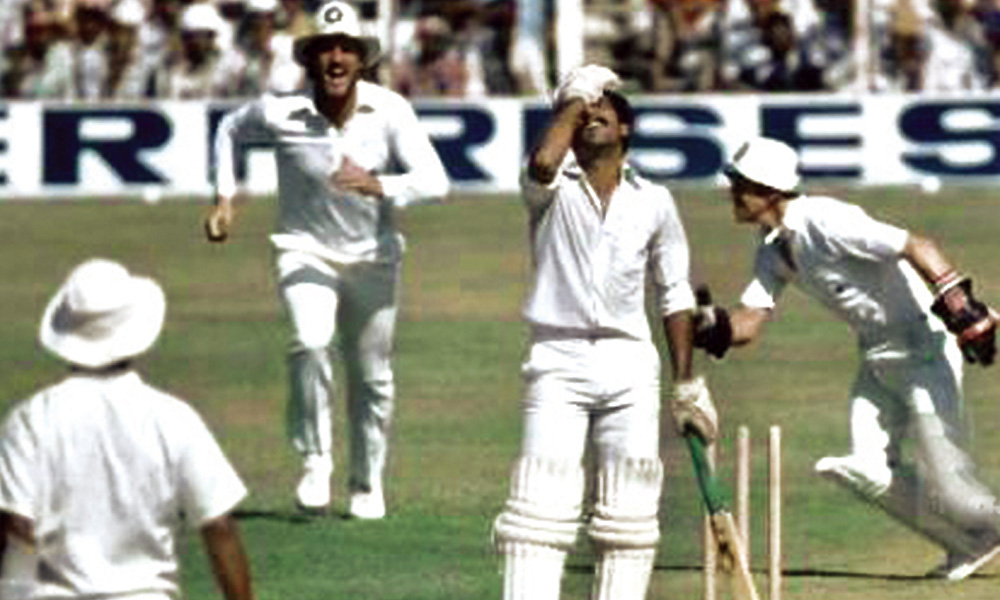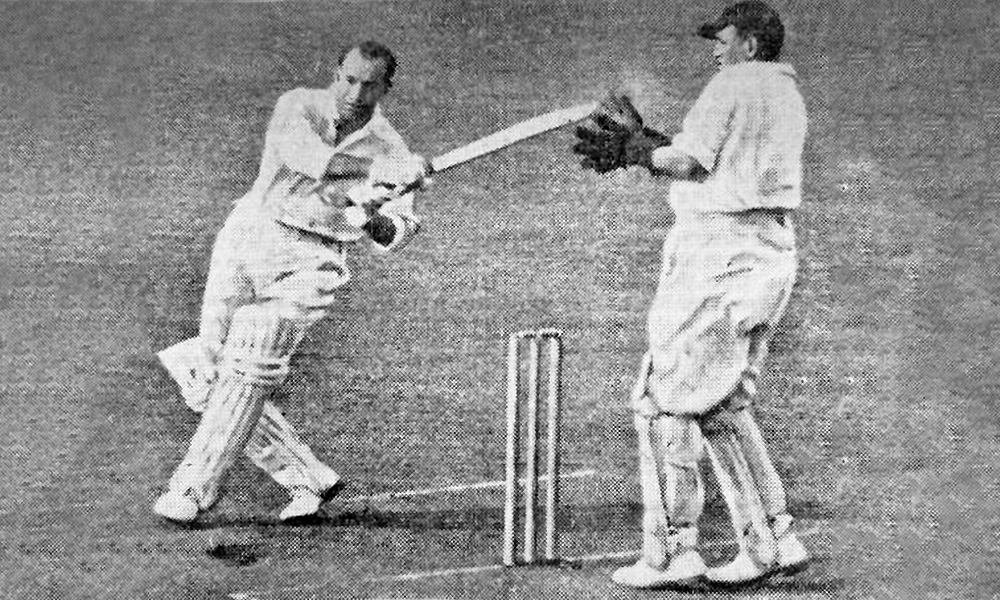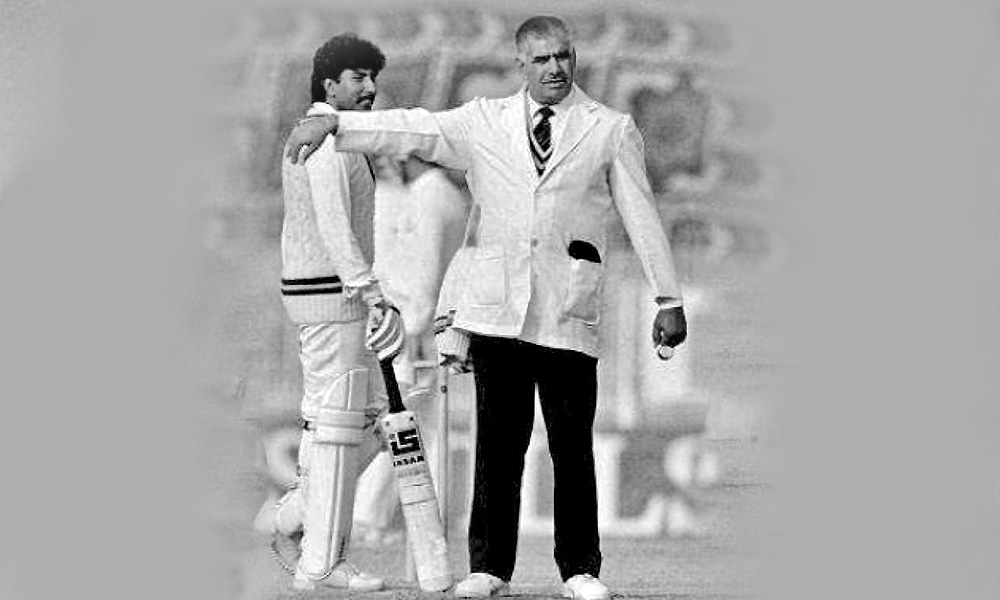The Ashes controversies have always added spice to the occasion. The most recent such controversy was seen in the second test at Lord’s when the crowd displayed a pathetically substandard behaviour. Even the behaviour and manners of the members of the MCC sitting in the long room or outside in their enclosure were much to be desired. The unthinkable behaviour of bad manners and rudeness was amply displayed which shamed the elite members of this prestigious club. The brilliant Australian batsman Usman Khwaja was not only heckled but was bodily pushed around in the member’s stand as the English defeat became imminent. It was a typical sad reaction of the English when things are not going their way. There are quite a few such incidents where the English did not uphold the traditions of cricket as a sport of the gentlemen by shunning the sportsman’s spirit. It’s not cricket, when in the face of defeat self-respect, dignity and the spirit of the game are overlooked. The recent incident happened when Bairstow was officially given out stumped by Carey off Green as he casually walked about outside the batting crease. He had missed the ball which had landed in the hands of the wicket keeper and the action was still not finished when Bairstow carelessly stepped outside the crease. An appeal was made and the Umpire took the right decision according to the rules to give him out. The decision completely baffled the batsman and the crowd including the MCC members booed to no end. Cummins, the Australian captain could have withdrawn the appeal but he did not. At the closing ceremony, former England captain, Mike Atherton asked Cummins that wasn’t it an unsportsmanlike action? To which Cummins replied that it was their right to appeal but it was up to the Umpire to take the decision. Guy Lavender, the chief executive of the MCC took immediate action against the unruly MCC members and suspended the membership of three members forthwith. He issued a letter to all the members of the MCC to appraise them not only of his action but also to warn members to refrain from bad manners.

A similar little spoken about incident happened in the second test of the 1928-29 Ashes series, when Don Bradman was dropped for Alan Kippax who was touted as the next Victor Trumper. Facing a ball from seamer George Geary, Kippax planted his left leg outside the leg stump to meet the ball with a swing but missed. The ball thudded into his pad, dribbled around his leg and knocked the bails off. Kippax stayed put as the England fielders appealed to the other Umpire who saw everything and told Kippax he had been bowled off the pads. Kippax assumed that Wicket Keeper George Duckworth might have tempted to dislodge a stump using his knee as Monty Noble in the press box ranted that the decision should have been taken by the bowler’s side Umpire. As Kippax stood put at his crease, Jack Hobbs, standing near the square leg Umpire said, “What are you doing, standing there when you’re out?” The only instance of a bad remark by Hobbs. Kippax walked off flushed red with indignation. As he walked passed Harold Larwood, he heard him mutter a sharp expletive. The All India Wicket Keeper Batsman Dilawar Hussain who appeared for India in 1936 was often suspected and accused of keeping small pebbles in his mouth to blow away the bails of the unsuspecting batsman. His pranks and wit always brought much laughter in the game.

On December 13, 1947, Vinoo Mankad touring Australia with India on its inaugural tour, ran out Bill Brown on the non-striker’s end in the Sydney test. Mankad had warned him twice earlier to remain in the crease but Mankad had to stump him in his delivery stride as Brown was yards outside the crease. It angered a lot of people and a new phrase ‘Mankading’ was coined in a derogatory way but Mankad had done no wrong and was only following the rules.

In 1956, the MCC ‘A’ team touring Pakistan landed in trouble when they manhandled Umpire Idris Beg during the fourth test at Peshawar for making some unfavourable decisions. The tour was almost cancelled due to the ugly incident. It was at the intervention of Lord Altham and the President of Pakistan Iskander Mirza, the tour was completed but it certainly left a bad taste. Roy Swetman, one of the main culprits in the incident, is now 86 but was the youngest team member then. There was some disillusionment when Sir Garfield Sobers, touring Pakistan with the West Indies team in 1959, was given out lbw a few times. In Dacca test when he was given out lbw to Pakistan captain Fazal Mahmood, he was yards outside the crease. As he was walking away, Wicket Keeper Imtiaz Ahmed and Ijaz Butt, both told the captain to call him back as he was not out but Fazal ignored their counsel.

In 1981, Srikanth of India, making his debut at Mumbai against England was out in a similar way when he casually walked out of the crease before the ball completed its action and was stumped. In 1989 Srikanth was called back by Pakistan captain Imran Khan after being given out lbw to Waqar Younis in the ODI at Lahore between India and Pakistan. Technically the captain had no authority to call him back after being given out, but Srikanth was out next ball caught behind off Waqar Younis. In the second ODI between India and South Africa of the World Cup 1992, Kapil Dev stumped Kirsten in his bowling stride who kept going yards outside the crease, after warning him a couple of times. The incident between England captain Mike Gatting and Umpire Shakoor Rana is yet another glaring example of gross misconduct on the part of the touring captain. Shakoor Rana acted perfectly within the rules of the game and took an upright stance. The behaviour of the English captain was clearly, ‘It’s not cricket’. Every team wants to win but they need to keep their adrenaline in check to follow the rules of the game and never forget cricket is a sport of gentlemen.
In a one- of-a-kind fest, Alyssa Healy and Meg Lanning, in recent times advanced the league to new heights, in a very precise way. The dynamic brace embarked on a unique adventure, taking the coveted WBBL jewel to the zenith of Sydney the iconic Sydney Tower Eye, which soars to a stirring 1,014 bases above the Central Business District.

Thrilled by the unknown experience, Meg Lanning, the Melbourne Stars’ captain, participated her excitement about the forthcoming WBBL season, saying,” noway ahead have I been to similar stunning heights. It’s outstanding instigative, and I cannot live for the occasion to begin.”
Alyssa Healy, a vital participant for the Sydney Sixers, expressed her enthusiasm for the WBBL’s enduring enchantment after ninetimes, Stating,” It’s exceptional to peer that in any case this time, the WBBL continues to be as exciting as ever. ”
In an interesting flip of events, Meg Lanning additionally praised the selection to consist of justice withinside the Olympics, remarking,” This is an awesome selection. ” She went directly to explicit her delight, adding,” I am happy to look justice being covered withinside the Olympics.It’s a enormous vault in an effort to honestly increase the sport to new heights.”
Alyssa Healy, who had preliminarily showcased her gift in the Women’s IPL, participated her enjoyment of The experience, urgent her enthusiasm for the developing possibilities of women’s justice on the worldwide stage.
She also raised their desire to see further Indian players share in the WBBL, emphasizing the league’s commitment to inclusivity and its implicit to further diversify the gift pool.
WBBL season 09 is to be commenced on 20 oct, Friday from North Sydney Oval in which Sydney Sixers to face- off Melbourne Stars withinside the start game.
The last time Pakistan won a Test match at ‘home’ was against the West Indies at the Sheikh Zayed Stadium in Abu Dhabi in October 2016 – exactly two years ago. Since then the home team have lost three Tests – one against West Indies, two against Sri Lanka and drew one Test versus Australia in their adopted home. If we don’t hear the alarm bells ringing then there must be something wrong with our hearing.
It was somewhat expected that Australian team under the new leadership – Tim Paine (captain) and Justin Langer (coach) will be a different proposition if compared to the Australian team which paid a visit to the UAE in 2014; but to secure a draw against the home team Pakistan in the first Test of the series is a moral victory for the visitors.
It’s almost like that Pakistan team have lost the recipe to win a Test at home. Team selection for the matches against the Lankans in 2017 was appalling, to say the least. One must acknowledge that this time around the selection was much better. That said, one mustn’t forget that Hafeez wasn’t included in the team until the eleventh hour. And look what he did in the Test match – he made a magnificent hundred on his comeback. Perhaps our selection cognoscenti were unaware that Hafeez is called ‘the king of UAE’. Imagine if he had played the Asia Cup!
It is good that Hafeez has made a thumping comeback and one can hope that more big scores are in the offing; especially against New Zealand in the forthcoming series. The only problem is that he’s batting at wrong position. He could’ve been ideal at number four or five in the batting order since he can provide stability in the middle order with his experience and Azhar Ali would’ve retained his position as an opener.
The Pakistan team is scheduled to tour South Africa for three Test matches later in the year. It would be unwise to send Hafeez as an opener in South Africa considering his woeful performances in Test matches in the past. As far as limited overs cricket is concerned he could be useful at any number.
The off-spinner Bilal Asif made his debut owing to indisposition of Shadab Khan who is nursing an injury. Bilal took six scalps on his debut. An off-spinner should have been the first choice, considering the number of left-handers in the Australian batting line-up. Thankfully, fate worked in Bilal’s favor.
Wahab Riaz looked rusty and out of sorts. Perhaps he wasn’t ready for a comeback, but the team management wanted a bowler with sheer pace who could reverse swing the ball, which is understandable. Though, Mohammad Abbas has proved this notion wrong by performing on all types of pitches – from the dry 22 yards in the barren UAE to the misty conditions in county cricket in England.
Mir Hamza – the talented left- arm pacer is warming the bench. Perhaps the team management could replace him with Wahab Riaz in the second Test at Abu Dhabi. Junaid Khan would have been the ideal choice, but he was sent back home after an excellent performance in a solitary match in the Asia Cup in which he took 4 wickets for 19 runs against Bangladesh.
Babar Azam is an extremely talented batsmen; his ODI record and an average of 51.92 proves that, but he hasn’t been able to live up to expectations in Test matches. A Test average of 28 for a frontline batsman is nothing to write home about. He has been fortunate to appear in Test matches on a regular basis when a player like Fawad Alam, with a Test average of 41.66 and first-class average of 55.66 languishes in domestic circuit.
If Australia manages another draw or a win at Abu Dhabi, Pakistan team will be in shambles. New Zealand team might prove a tough nut to crack especially playing against a home team with low spirits. The alarm bells are ringing; it’s time to put our house in order.
“C’mon Lillee C’mon” was the chant which reverberated through the MCG in the seventies whenever Australia’s favorite son held the red cherry in his hand on top of his run, ready to prowl upon the lonely figure standing far away at the wicket with a mere cricket bat in his hand as a defense.
As Lillee stepped into his rhythmic run up and picked up pace, the chants grew louder and reached absolute frenzy when Lillee exploded into his beautiful and animated delivery stride before releasing his 90 mph thunderbolt. A sight to behold indeed!

Though not comparable in stature to his fellow countryman Donald Bradman, Lillee remains the first pick amongst the fast bowlers whenever any scribe or former player or even a panel pencils down bowling choices for an all time World XI.
One can argue about Shane Warne or Muttiah Muralitharan just like for majority of other places in the all-star side with players to choose from rich history of 140 plus years, yet Lillee remains the undisputed leader of the fast bowling pack ever to grace any cricketing green.
What made Lillee so special? It was not about sheer pace. There have been bowlers who bowled at a pace quicker than him like his team mate Jeff Thomson and the entire killer squad of the Caribbean pace battery of the seventies and eighties.
Was it swing and seam? Pakistan’s lot led by Imran Khan and Wasim Akram combined lethal pace with masterly reverse swing or the English and Kiwi bowlers like Alec Bedser and Richard Hadlee, who were the most disciplined and yet the most penetrative of the lot. Lillee is rated above all of them solely due to the reason that he was a complete fast bowling package. A master his craft. He was an aggressor with mind of a genius. Speed, athleticism, craft, ingenuity, passion, rebellion and showmanship, all these traits molded into this one lithe frame of West Australian origin to form the greatest fast bowler of all times.
Controversies followed Lillee like a media star. Be it his on the field combat against Pakistani skipper Javed Miandad when Lillee kicked Miandad or be it the small matter of betting against his own team on the 1981 tour of England when he and his mate wicket keeper Rod Marsh put a ten pounds wager which they later referred as a mere joke, Lillee was the enfant terrible of his cricket times.

In mere 70 Tests their joint tally of 95 victims forms almost 27% of Lillee’s 355 Test match scalps. Surprisingly they supersede more obvious choices like McGrath/Gilchrist, Warne/Healy. Warne/Gilchrist and Muralitharan/Sangakkara.
The top of the lot however was when in 1979 Lillee in a Test match against England, walked on to the playing field with an aluminum bat instead of the standard wooden version and started batting with it. When umpires noticed and objected to it Lillee entered into an on the field heated exchange with the umpires and English skipper Mike Brearly. When he was finally forced by his own skipper Greg Chappell to use the standard version, Lillee used all his strength to throw away the aluminum bat like a javelin, which landed some forty meters ago.
Astonishingly Lillee’s act of total insubordination and subsequent outrage was totally ignored and he was not even reprimanded by either ACB or ICC. Imagine such an incident happening today and the player irrespective of his standing going unpunished. Inconceivable!
Lillee’s greatest partnership was not with one of his fast bowling mates but with the man titled “Iron Gloves” who stood behind stumps throughout Lillee’s career and scooped off 95 catches off Lillee’s bowling. Yes its Rod Marsh, Lillee’s partner in crime and best mate hailing from the then unfashionable state of Western Australia and together they went on to become the most prolific bowler-keeper partnership in the history of the game.
In mere 70 Tests their joint tally of 95 victims forms almost 27% of Lillee’s 355 Test match scalps. Surprisingly they supersede more obvious choices like McGrath/Gilchrist, Warne/Healy. Warne/Gilchrist and Muralitharan/Sangakkara.
Another record which Lillee holds is the maximum number of wickets by a fast bowler in a calendar year. He took 85 wickets in Test matches during 1981 and subsequently only two spinners Warne and Muralitharan have exceeded his feat and no fast bowler has been able to challenge his unique accomplishment.
On the bowling crease Lillee has partnered a host of characters who represented Australia with varying degree of success and distinction. In early seventies it was Bob Massie who shone brightly on the 1972 tour England, taking 16 wickets in his debut match at Lord’s and sliding back into oblivion as quickly as he had emerged. Max “Tangles” Walker, Gary Gilmour and Len Pascoe also had brief stints but his most renowned and feared combination was with Jeff Thomson arguably the fastest bowler ever and definitely the fastest one around in the seventies. Together with Thomson, Lillee formed a pace bowling strike force with very few rivals in the history of the game.
“Ashes to ashes, dust to dust, If Thommo doesn’t get ya, Lillee must”
This was the war cry touring Englishmen were subjected to on the 1974-75 Ashes series in Australia when their strong batting line was reduced to a collection of mentally and physically broken individual all unwilling to venture to the batting crease by the Lillee -Thomson pairing. The same treatment was handed over to the West Indians over the next season that were a much more courageous lot and yet ended up with similar results.
Lillee’s next major bowling partner was another West Australian Terry Alderman who with a deceptively smiling exterior but a masterly control over swing and seam established himself in the Australian side. It was in Lillee’s mentorship that Alderman and Geoff “Henry” Lawson went on to become world class opening bowlers.
His performance in the Centenary Test at the same venue against old foes England and his memorable afternoon burst against the 1977 touring Pakistanis which cut their strong batting line down from a comfortable 270 for 2 to 333 all out are also two of his legendry master pieces.
This mentorship highlighted another aspect of Lillee’s awesome personality and talent which was put to great use by the Indians after Lillee’s retirement who appointed him as the head of Indian pace bowling academy in Chennai which changed the mindset and orientation of Indian bowling attack from an all spin to a more balanced pace-spin combo. Under Lillee’s tutorship this academy yielded a number of good Indian fast bowlers like Javagal Srinath and since then India is no longer regarded as a spin dominated attack capable of performing only in India.
Melbourne’s MCG remained Lillee’s favorite hunting ground despite its sluggish wicket. Perhaps it was the Boxing Day magic which inspired Lillee to scale greater heights. Lillee broke West Indian off spinner Lance Gibbs’s world record for most Test match wickets at the MCG. He also recorded his best bowling figures in an innings against the West Indies there and four of his seven career ten wicket hauls came in Melbourne.

His performance in the Centenary Test at the same venue against old foes England and his memorable afternoon burst against the 1977 touring Pakistanis which cut their strong batting line down from a comfortable 270 for 2 to 333 all out are also two of his legendary master pieces.
Lillee’s true grit is judged by the way he fought two career ending stress fractures of the back in 1973 and 1977 and emerged a fitter and even more ferocious bowler. It was Lillee who transformed the art of appealing from a polite and submissive enquiry to the umpire to a life threatening ultra- aggressive finger pointing mannerism which was later adopted by many generations of fast bowlers.
However the sight of Lillee pleading his case in the most emphatic way remains one the most original and compelling sights of cricket. If there was one cricketer who could hold his own in the Hollywood Western classics challenging John Wayne and Clint Eastwood, it was Dennis the Menace.